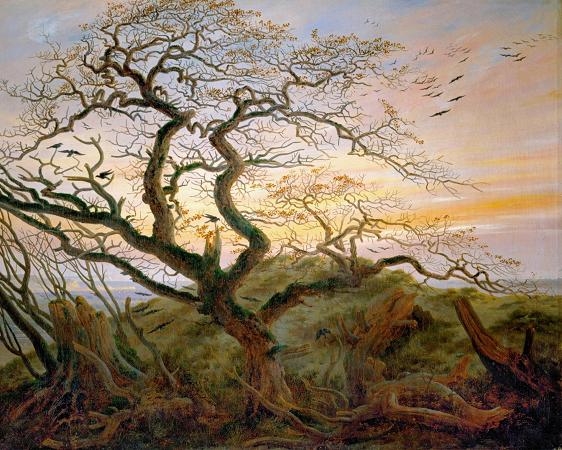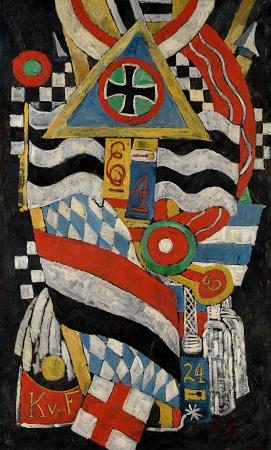Charles Burchfield (1893 - 1967). Charles Ephraim Burchfield was an American painter and visionary artist, known for his passionate watercolors of nature scenes and townscapes. The largest collection of Burchfield's paintings, archives and journals are in the collection of the Burchfield Penney Art Center in Buffalo. His paintings are in the collections of more than 109 museums in the USA and have been the subject of exhibitions at the Metropolitan Museum of Art, the Whitney Museum of American Art, the Hammer Museum, and the Museum of Modern Art, as well as other prominent institutions. Born in Ashtabula, Ohio, Burchfield was raised by his widowed mother in Salem, Ohio. Most of his early works were done at this house, where he lived from the ages of five to 28, and which has since been converted into a museum. While he did think of being a nature writer in high school, he eventually focused entirely on the visual aspect of his creativity, writing short descriptive pieces for the painting on the back of the mount. Stimulated by the nature descriptions of others, his preferred American writers were Thoreau and Willa Cather and later he developed a passion for reading works by Finnish writers describing nature. Burchfield graduated from the Cleveland Institute of Art in 1916. Later in life he acknowledged the profound effect on his own development by a teacher at the CIA, the artist Henry Keller. Keller led a generation of Ohio watercolor painters of the Cleveland School which included Burchfield. On becoming engaged, Burchfield moved to Buffalo, New York in 1921, where he was employed as a designer at the H.M. Birge wallpaper company. The following year he married Bertha Kenreich in Greenford, Ohio. In 1928 with a fifth child on the way, he approached artist-gallerist Frank Rehn to see whether he could afford to paint full-time by selling through the Rehn gallery in New York. Though the decision to leave Birge preceded the Great Depression, his work continued to sell. In 1952, he was elected to the National Academy of Design as an Associate member, and became a full member in 1954. In 1925, Burchfield had moved from Buffalo to the adjacent suburb of West Seneca, New York, spending the rest of his life in the rural neighborhood of Gardenville. He is buried in Oakwood Cemetery in the Village of East Aurora, New York. According to Burchfield's friend and colleague Edward Hopper, The work of Charles Burchfield is most decidedly founded, not on art, but on life, and the life that he knows and loves best.Burchfield has been more recently described as the mystic, cryptic painter of transcendental landscapes, trees with telekinetic halos, and haunted houses emanating ectoplasmic auras. Jerry Saltz suggests his influences as van Gogh, Caspar David Friedrich, Marsden Hartley, John Marin, calendar art, and Sunday painting. Like Hopper, he seemed to have left cubism out of the equation. Since its heyday in the nineteenth century, watercolor had remained a popular style, but Burchfield was unique among his major contemporaries for working exclusively within the medium. Unlike most watercolorists, he stood at an easel. He applied his colors with a dry brush technique on machine-made paper, often reworking the surface during the process or sometimes many years later. Burchfield was an unflagging advocate for the virtues of watercolors, and chafed at the popular misconception of them as fragile and impermanent. He was aware that some fading and hue changes were likely to occur, but believed that proper handling and display procedures would keep water-based artwork as vibrant as any other medium. Modern curators typically show watercolors like Burchfield's under reduced lighting and for shorter lengths of time than oil-based exhibitions. His work is usually divided into three periods comprising: figuration; houses and small town scenes; and abstractions depicting moods. Insect and frog sounds have their own calligraphic strokes, and cicada sounds are depicted with zigzag strokes radiating outward; flowers and houses seem to have faces, not always pleasant. Burchfield's style was largely developed by the summer of 1915, after his junior year at the Cleveland School of Art, as he sketched and painted constantly in and around Salem, OH, gathering the materials for a lifetime, according to his journals. Exposed in school to modernist European trends, he developed an almost fauvist use of broad areas of simplified color. He was enlivened by delightful particularizations of nature, and in 1917, began combining visual motifs projecting human moods, often disturbing, into the pictures. Assigned to the camouflage unit in the Army in 1918, he even worked his designs into painting schemes disguising tanks and artificial hills.
more...













